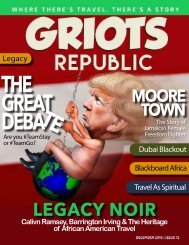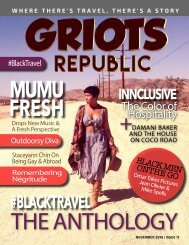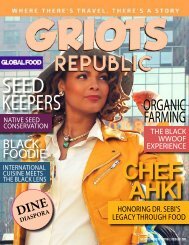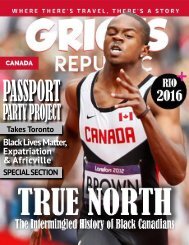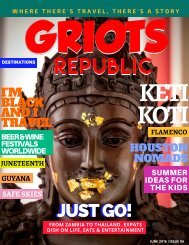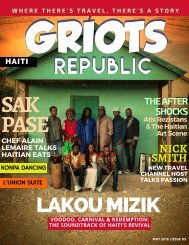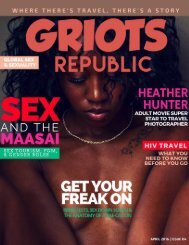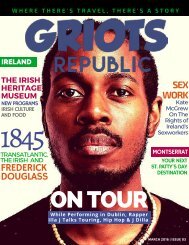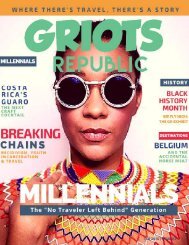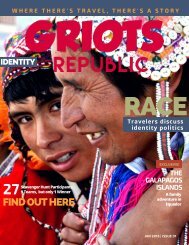GRIOTS REPUBLIC - AN URBAN BLACK TRAVEL MAG - OCTOBER 2016
In the October Issue of Griots Republic we cover GLOBAL DESIGN! From interior to sound design we plug into the subjects that interest urban travelers. Black Travel Profiles include: Brooklyn Circus Founder, Ouigi Theodor. Up In Air Life Founder, Claire Soares. Fashion Influencer, Jason Andrew and Blogger A.V Perkins of A.V Does What. This issue also includes interviews with International D.J., DJ Super Nova and street artist and designer Jerry Gant. This is Black Travel!
In the October Issue of Griots Republic we cover GLOBAL DESIGN! From interior to sound design we plug into the subjects that interest urban travelers. Black Travel Profiles include: Brooklyn Circus Founder, Ouigi Theodor. Up In Air Life Founder, Claire Soares. Fashion Influencer, Jason Andrew and Blogger A.V Perkins of A.V Does What. This issue also includes interviews with International D.J., DJ Super Nova and street artist and designer Jerry Gant. This is Black Travel!
You also want an ePaper? Increase the reach of your titles
YUMPU automatically turns print PDFs into web optimized ePapers that Google loves.
was an oral language until the 20th Century.<br />
The traditional arts of wood carving,<br />
basket weaving and knots were what<br />
helped the various iwi (tribe) understand<br />
each other. One’s moko, then, is also a<br />
way of communicating with others. It allows<br />
someone to know one’s place within<br />
one’s iwi. For someone like Chief Kingi<br />
Taurua, his moko demonstrates his role<br />
as an orator. For others like Academic<br />
Te Kahautu Maxwell, it is a symbol of his<br />
eternal tears for the loss of his daughter<br />
who passed away suddenly.<br />
There are many influences that go into<br />
a moko. It is not something to be undertaken<br />
lightly. There is a ritual of consent,<br />
whakapapa (genealogy) and history. The<br />
whakapapa is an important component<br />
of Māori culture. It allows individuals to<br />
know and present themselves. A people<br />
connected to nature, Māori have a wider<br />
concept of belonging. Thus, there are<br />
layers to where one is from. In reciting<br />
one’s pepeha (introduction), it is imperative<br />
that one know in the following order<br />
one’s māunga (mountain), awa (river),<br />
waka (canoe)*, tōku tīpuna (founding<br />
ancestor) *, iwi, hapū (sub-tribe), marae<br />
(meeting grounds)*, where one is from,<br />
one’s parents and one’s own name.<br />
Rotorua native, Rawiri Bhana explains<br />
how he had his moko “done on [his marae<br />
[with] permission granted by [his] kaumatua<br />
(elders) in two straight sessions.”<br />
They lasted 11 and six hours, respectively.<br />
His iwi, Te Arawa, takes their name from<br />
the mango pare (hammerhead shark),<br />
who followed and protected his tīpuna’s<br />
waka when they made their initial voyage<br />
from Raaiatea to Aotearoa. Thus, Bha-




